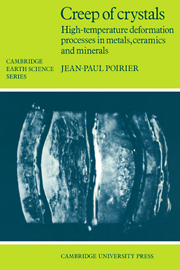Book contents
- Frontmatter
- Contents
- Preface
- 1 Mechanical background
- 2 The agents of deformation: lattice defects
- 3 Phenomenological and thermodynamical analysis of quasi-steady-state creep
- 4 Dislocation creep models
- 5 The effect of hydrostatic pressure on deformation
- 6 Creep polygonization and dynamic recrystallization
- 7 Diffusion creep, grain-boundary sliding and superplasticity
- 8 Transformation plasticity
- 9 Scaling and classification
- References
- Materials index
- Subject index
8 - Transformation plasticity
Published online by Cambridge University Press: 06 October 2009
- Frontmatter
- Contents
- Preface
- 1 Mechanical background
- 2 The agents of deformation: lattice defects
- 3 Phenomenological and thermodynamical analysis of quasi-steady-state creep
- 4 Dislocation creep models
- 5 The effect of hydrostatic pressure on deformation
- 6 Creep polygonization and dynamic recrystallization
- 7 Diffusion creep, grain-boundary sliding and superplasticity
- 8 Transformation plasticity
- 9 Scaling and classification
- References
- Materials index
- Subject index
Summary
Transformation plasticity is a weakening of the mechanical properties of a polycrystal while it is undergoing a phase transformation. It must be distinguished from other processes linked to phase transitions, like the so-called ‘Transformation-Induced Plasticity’ which makes steels tougher.
After a brief review of the thermodynamics and kinetics of phase transformations, the experimental evidence for transformation plasticity in metals and ceramics is presented. The macroscopic model of Greenwood & Johnson, inspired from ‘yielding creep’ models, is reviewed: it considers that the internal stresses caused by the volume change of grains overcome the yield strength of the solid and make it flow under small stresses. Microscopic models are presented, in which the internal stress is relaxed by dislocations that move under the applied stress.
Introduction
We will define transformation plasticity as a weakening of the mechanical properties of polycrystal, while it is undergoing a phase transformation. The manifestations of transformation plasticity are:
(i) an enhanced creep-rate, above the thermal creep-rate, in the case of creep at constant stress.
(ii) a stress drop, in the case of constant strain-rate tests.
These manifestations cease when the phase transformation is over. Transformation plasticity, therefore, has nothing to do with the change in mechanical properties consecutive to a phase transition (e.g. the creep-rate of α-Fe changes to the creep-rate of γ-Fe after the α–γ transformation is completed); it is really a manifestation of the interaction between phase transformations and plastic deformation.
- Type
- Chapter
- Information
- Creep of CrystalsHigh-Temperature Deformation Processes in Metals, Ceramics and Minerals, pp. 213 - 228Publisher: Cambridge University PressPrint publication year: 1985



